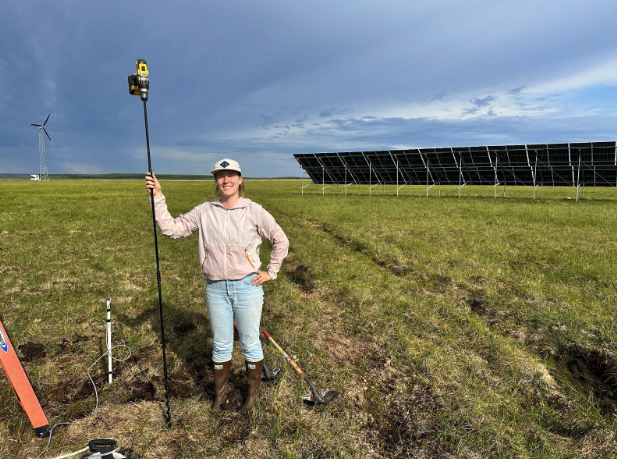A summer intern contributes to empowering solar future in Alaska
August 24, 2023

Kathryn Modler installs the ground temperature monitoring system she designed to gain knowledge about whether and how the shifting permafrost causes some of the panels to heave around the solar array in Kotzebue, Alaska.
This article is part of a series highlighting ACEP’s 2023 cohort of eighteen undergraduate interns. To read about other projects and learn more about the program, please visit the ACEP Internship Program website.
Kathryn Modler came to Alaska from the University of North Carolina at Chapel Hill, where she studies energy physics and quantitative energy systems. Originally from Colorado and Canada, Modler was thrilled to return west for the summer to spend time outside and learn more about the applications of solar energy in the North.
Under the guidance of her mentor Chris Pike, Modler assisted the Solar Technologies program at ACEP on a variety of tasks. She completed weekly maintenance of the solar photovoltaic test site and weather station on the University of Alaska Fairbanks Troth Yeddha’ Campus and assisted UAF Ph.D. student Rich Strömberg with solar degradation testing. She also spent time gathering production data to compile a comparative report regarding high-tilt roof mounted solar arrays and flush-mounted systems in the Fairbanks area.
Modler’s main project this summer involved designing and building a ground temperature monitoring system for the solar array in Kotzebue. She planned three ground temperature monitoring thermistor strings, and built, programmed, and installed the systems on site in Kotzebue.
Modler’s work has several implications for Alaska and its residents in the realm of solar energy utilization. The state, by providing more knowledge and data, is working toward a better understanding of how this renewable resource can be harnessed effectively in a region with difficulties that include extreme weather, remoteness, and challenging geotechnical conditions. These projects demonstrate the value of on-the-ground research and community-oriented solutions that will ultimately lead to the most impactful results for the future.
This internship was especially unique because Modler was able to see through a project from beginning to end in Kotzebue.
“I was able to see the questions being asked, design a solution, use my own hands to build the solution, and see that it was installed and working!”
Modler was thrilled for the opportunity to work with Pike on challenges that accompany an atypical system due to its remoteness.
“The leadership and experience that [Pike] has provided is so valuable for my learning and growth as a student and professional in this field. His appreciation for this state and the work we were doing is truly inspiring,” she said.
This internship is funded by the Office of Naval Research through the ACEP Undergraduate Summer Internship program. View the final presentation for this project on ACEP’s YouTube Channel. For more information on this project, please contact Chris Pike at cpike6@alaska.edu.


